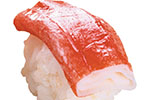Food & Beverage Manufacturing
Meat & Seafood
Formulators can help invigorate meat and seafood on a global scale with the help of U.S. dairy ingredients. These ingredients can help reduce cost and improve nutritional profiles while maintaining and creating the flavors consumers crave.
A variety of functional benefits are also available through U.S. dairy ingredients. Concentrated and dry milk ingredients enhance stable emulsifications and provide water-binding properties. Lactose boosts color intensity, helps control browning and masks salty and bitter flavors. Whey proteins contribute to a food's healthful image, provide outstanding fat distribution and improve water retention and texture. These attributes, among many others, help food and beverage manufacturers develop better meat and seafood products. Dairy ingredients and products from the United States help product developers keep on-trend with innovation in the meat and seafood category. Learn more about U.S. dairy products in the Product Section.

Trends in Meat and Seafood
Shifts in dietary trends as well as economic factors are behind per capita declines in U.S. meat consumption over the last decade. As consumers reduce portion sizes or eliminate red meat from one or more meals per week to trim budgets, calories or cholesterol, they consume less red meat in favor of poultry or protein substitutes.1
However, meat and seafood product category sales continue to represent demand growth opportunity for consumer convenience products in frozen and refrigerated retail cases.
Consumer Convenience
From globally inspired herb flavors to smoked and fruit fusions, new meat products trend toward the flavorful. Value-added convenience products also appeal to consumers with either limited cooking skills or lack the time for traditional meat preparation.
Convenience factors foster meat and seafood product development, with ready-to-eat and portion-control items key trends expected to drive sales.
Dairy ingredients such as milkfat and a variety of whey products, including sweet whey, whey protein concentrate and whey protein isolate, can help act as flavor carriers to help these products taste as good as they sound.
Utilization
U.S. dairy ingredients offer meat and seafood formulators a wide variety of options that will allow them to meet consumer trends. Ingredients such as cheese, lactose, milkfat, milk powders and whey proteins can help enhance numerous applications, ranging from bratwurst and bologna to surimi.
The below chart illustrates the benefits five common dairy ingredients offer.
| Cheese (Details) | Lactose (Details) | Milkfat (Details) | Milk Powders (Details) | Whey Protein(Details) | |
|---|---|---|---|---|---|
| Adhesion |  |
 |
|||
| Browning |  |
||||
| Color |  |
 |
|||
| Emulsification |  |
||||
| Fat Reduction |  |
 |
|||
| Flavor |  |
 |
 |
 |
|
| Gel Forming |  |
||||
| Moisture Retention |  |
||||
| Mouthfeel |  |
 |
|||
| Stability |  |
||||
| Texture |  |
 |
|||
| Water Binding |  |
 |
|||
| Cheese Details | Lactose Details | Milkfat Details | Milk Powder Details | Whey Details |
Formulas & Recipes
Access U.S. Dairy Export Council prototype formulations for inspiration formulating tasty meat and seafood applications, including bologna, sausages, ham, ground beef patties and surimi.
Resources & Insights
Looking for further innovation ideas and technical support? Download the resources below for more information on developing meat and seafood applications with U.S. Dairy.
U.S. Whey Proteins in Processed Meats
The use of whey ingredients in processed meats offers a variety of benefits, such as taste, texture and binding.
Advantages of Whey Proteins in Meats
Whey protein offers benefits that make it an excellent choice in a wide range of meat products.



